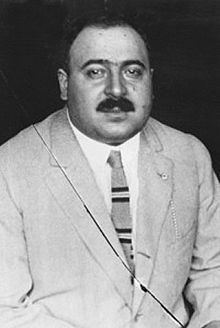Nationality Italian, American Name James Colosimo Resting place Oak Woods Cemetery | Religion Roman Catholicism Role Boss | |
Born February 16, 1878 ( 1878-02-16 ) Colosimi, Calabria, Italy Cause of death Multiple gunshot wounds Other names "Big Jim", "Diamond Jim" Occupation Businessman, Crime boss, Mafioso, Mobster, Racketeer Known for Boss of the Chicago Outfit Died May 11, 1920, Chicago, Illinois, United States Similar People Johnny Torrio, Dean O'Banion, Hymie Weiss, Jack McGurn, Frank Capone | ||
Gangsters in granite chicago style vol vii james colosimo
James "Big Jim" Colosimo (born Giacomo Colosimo) (February 16, 1878 – May 11, 1920), also known as "Diamond Jim," was an Italian-American Mafia crime boss who immigrated from Calabria, Italy in 1895, and built a criminal empire in Chicago based on prostitution, gambling, and racketeering. He gained power through petty crime and by heading a chain of brothels. From about 1902 until his murder in 1920, he led a gang that became known after his death as the Chicago Outfit. Johnny Torrio was an enforcer whom Colosimo imported in 1909 from New York and who seized control after his death. Al Capone, a Torrio henchman, allegedly was directly involved in the murder.
Contents
- Gangsters in granite chicago style vol vii james colosimo
- Early years
- Prostitution empire
- Help from New York
- Betrayal
- In popular media
- References

Early years
Colosimo was born Giacomo Colosimo to Luigi Colosimo and his second wife Giuseppina Mascaro in the town of Colosimi, Province of Cosenza, Italy. He emigrated to Chicago at the age of 17, starting out as a petty criminal. Colosimo attracted the attention of First Ward aldermen Michael "Hinky Dink" Kenna and John Coughlin. They made him a precinct captain and later their bagman. This gave Colosimo the political connections that helped him in his rise to power as a mob boss.
Prostitution empire

Later, Colosimo acquired another nickname, "Diamond Jim," because he frequently dressed in a white suit and wore diamond pins, rings, and other jewelry. This, combined with his personal charm and money, helped him establish relationships with women. He had a love of both women and money, which fueled his enthusiasm for prostitution. In 1902, Colosimo married Victoria Moresco, an established Chicago madame, and together they opened a second brothel. Within a few years, Colosimo had expanded this to nearly 200 brothels and had also made inroads into gambling and racketeering.
Help from New York
By 1909, Black Hand extortion was a serious threat to Colosimo in Chicago. He brought in gangster John "The Fox" Torrio from Brooklyn and made him his second in command. The following year, he opened Colosimo's Cafe, a restaurant and nightclub at 2126 South Wabash. It quickly became a popular destination for prominent Chicagoans and visitors to Chicago. In 1919, Torrio and Colosimo opened a brothel at 2222 South Wabash called the Four Deuces, a reference to the address. Torrio hired his old Brooklyn colleague Al Capone to work as a bartender and bouncer, which gave Capone his entry into Chicago crime. Although there's no longer a building at 2126 South Wabash there is a building with restaurant adjacent to 2222 South Wabash on Cermak street called "Chief Luciano" with a clover leaf symbol next to it which is a reference to Lucky Luciano, who was another New York gangster who joined the Chicago outfit gang.
Betrayal
When prohibition went into effect in 1920, Torrio pushed for the gang to enter into bootlegging, but Colosimo stubbornly refused. In May 1920, Colosimo left Chicago to marry his second wife, Dale Winter, having deserted Victoria Moresco. When he returned a week later, Torrio called and told him a shipment was about to arrive at his cafe. Colosimo drove there to await it, but instead he was shot in an ambush and killed. The initial suspect was his new wife Dale, but the murder officially went unsolved and no one was ever arrested or charged for it. Many believe that Torrio had ordered the killing so that he could go into the lucrative business of bootlegging. Torrio allegedly brought in a New York colleague, Frankie Yale, to eliminate Colosimo. Al Capone has also been suggested as the gunman.
Colosimo was the first gang leader to organize the disparate parts of Chicago's crime scene. After his death, John Torrio took over his gang, later to be replaced by Al Capone. His mob eventually became the infamous Chicago Outfit that ruled over some parts of the city.
